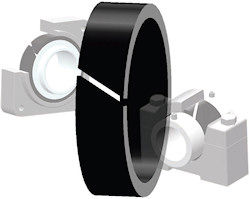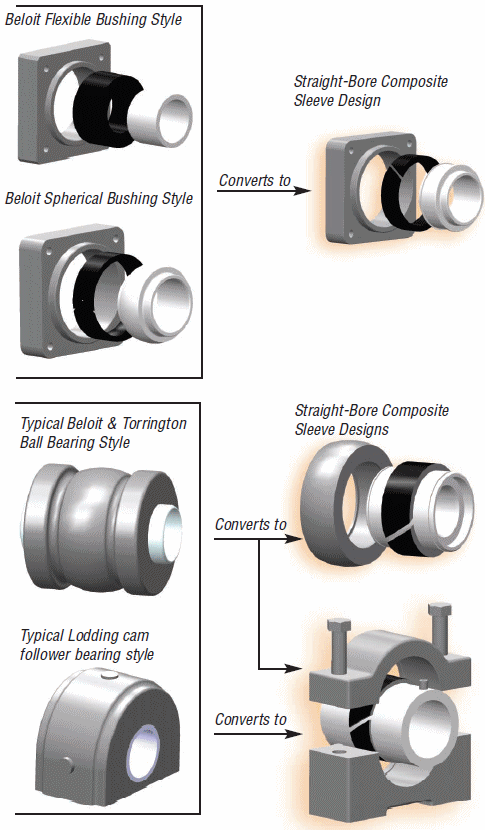Proper bearing lubrication and modernization are essential
Jun 23, 2020
Proper lubrication is critical to the success of bearings, which must endure compression pressures as high as 200,000 to 500,000 psi. Such stresses are great enough to deform the contracting surfaces in bearing housings.
Proper lubrication
Most bearing failures can be traced to two maintenance oversights: a lack of lubrication or the use of the wrong type of lubrication.
Lubrication is used to maintain a suitable film of lubricant between sliding parts in order to minimize metallic friction and protect against wear. It can also protect polished precision parts against rusting or corrosion. In some cases, the lubricant acts as a coolant, removing heat generated by friction and ambient conditions.
Selecting the correct type of oil or grease depends largely on three factors: speed, temperature and load.
Effect of speed
The choice of oil viscosity for an anti-friction bearing depends somewhat on peripheral speeds. For example, high-speed bearings require a relatively light-body oil to keep operating temperatures low. Low-speed bearings require heavier oil to protect against metal-to-metal contacts and wear.
Effect of temperature
High operating temperature makes oil less viscous, or grease softer. Also, high temperatures increase the oxidation rate of both oil and grease. Excessive oxidation can result in deposits that are detrimental to the bearing. Grease can become so stiff that lubrication fails. When anti-friction bearings are exposed, oil becomes more viscous. Low temperature oil or grease is used to reduce the friction, which can prevent the machine from starting. Even after the machine starts, the lubricant can be too viscous to distribute properly, and the bearing will wear until the lubricant warms up.
Effect of load
The greater the load on the bearing, the more viscous the lubricant becomes. Balls, rollers and raceways do not require high-viscosity lubrication in heavy load cases. A lubricant suitable for operating speed and temperature will protect against this wear. Also, oil viscosity can be a factor in resisting the wiping action of the rolling elements and reducing separator wear. Grease can reduce such wear if it penetrates clearances between cages, rolling elements and races. Heavy loads on tapered-roller and spherical-roller, radical and thrust bearings can force ends against the flanges of the races. This can wipe oil away, leading to rapid wear and early failure. In such cases, an anti-wear lubricant is often required.
Modernizing doctor oscillator bearings

Through the years there have been several different types of oscillator bearings used on paper machine doctors. They included flexible bushing type bearings, composite spherical sleeve bearings, Torrington ball bearing and Lodding cam follower bearings.
There is an easy way to retrofit and modernize these doctor oscillator bearings with a field proven design that provides smooth linear motion. It’s Valmet’s OEM composite straight-bore sleeve type bearing, the industry accepted bearing of choice. It can be easily adapted to most doctor applications throughout the paper machine.
Converting to straight-bore sleeve bearings is easy!

Design features of the straight-bore composite sleeve bearing retrofit
The housing and sleeve are built with corrosion-resistant 316 stainless steel. The assembly uses a self-lubricating bearing material that is chemically inert, will not absorb water and has adequate compliancy to compensate for minor misalignment. It is unaffected by harsh wet conditions and typical machine operating temperatures. Housing designs limit the amount of debris that can enter the bearing surface area. There is a low replacement cost, as the bearing sleeve is easily replaced while all other parts are reused. The low coefficient of friction of the bearing allows the existing doctor oscillator to be reused.
What are the benefits?
- Provides smooth linear motion that: improves doctoring, improves blade wear, reduces picking/crumbing, improves web draws/tail transfer and extends roll cover/face life for longer roll change intervals.
- Wears longer and is self lubricated.
- Less costly to replace
- Saves time and money on doctor bearing maintenance.
Simplify the task of keeping doctors oscillating properly by converting to the latest design straight-bore composite type bearings. Your Valmet representative will help you select the easiest and the most economical conversion option.
For more information on maintaining and modernizing your bearings, contact your Valmet representative.